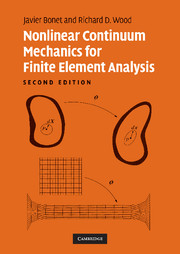Book contents
- Frontmatter
- Contents
- Preface
- 1 INTRODUCTION
- 2 MATHEMATICAL PRELIMINARIES
- 3 ANALYSIS OF THREE-DIMENSIONAL TRUSS STRUCTURES
- 4 KINEMATICS
- 5 STRESS AND EQUILIBRIUM
- 6 HYPERELASTICITY
- 7 LARGE ELASTO-PLASTIC DEFORMATIONS
- 8 LINEARIZED EQUILIBRIUM EQUATIONS
- 9 DISCRETIZATION AND SOLUTION
- 10 COMPUTER IMPLEMENTATION
- Bibliography
- Index
1 - INTRODUCTION
Published online by Cambridge University Press: 06 July 2010
- Frontmatter
- Contents
- Preface
- 1 INTRODUCTION
- 2 MATHEMATICAL PRELIMINARIES
- 3 ANALYSIS OF THREE-DIMENSIONAL TRUSS STRUCTURES
- 4 KINEMATICS
- 5 STRESS AND EQUILIBRIUM
- 6 HYPERELASTICITY
- 7 LARGE ELASTO-PLASTIC DEFORMATIONS
- 8 LINEARIZED EQUILIBRIUM EQUATIONS
- 9 DISCRETIZATION AND SOLUTION
- 10 COMPUTER IMPLEMENTATION
- Bibliography
- Index
Summary
NONLINEAR COMPUTATIONAL MECHANICS
Two sources of nonlinearity exist in the analysis of solid continua, namely, material and geometric nonlinearity. The former occurs when, for whatever reason, the stress strain behavior given by the constitutive relation is nonlinear, whereas the latter is important when changes in geometry, however large or small, have a significant effect on the load deformation behavior. Material nonlinearity can be considered to encompass contact friction, whereas geometric nonlinearity includes deformation-dependent boundary conditions and loading.
Despite the obvious success of the assumption of linearity in engineering analysis, it is equally obvious that many situations demand consideration of nonlinear behavior. For example, ultimate load analysis of structures involves material nonlinearity and perhaps geometric nonlinearity, and any metal-forming analysis such as forging or crash-worthiness must include both aspects of nonlinearity. Structural instability is inherently a geometric nonlinear phenomenon, as is the behavior of tension structures. Indeed the mechanical behavior of the human body itself, say in impact analysis, involves both types of nonlinearity. Nonlinear and linear continuum mechanics deal with the same subjects such as kinematics, stress and equilibrium, and constitutive behavior. But in the linear case an assumption is made that the deformation is sufficiently small to enable the effect of changes in the geometrical configuration of the solid to be ignored, whereas in the nonlinear case the magnitude of the deformation is unrestricted.
Practical stress analysis of solids and structures is unlikely to be served by classical methods, and currently numerical analysis, predominately in the form of the finite element method, is the only route by which the behavior of a complex component subject to complex loading can be successfully simulated.
- Type
- Chapter
- Information
- Publisher: Cambridge University PressPrint publication year: 2008

